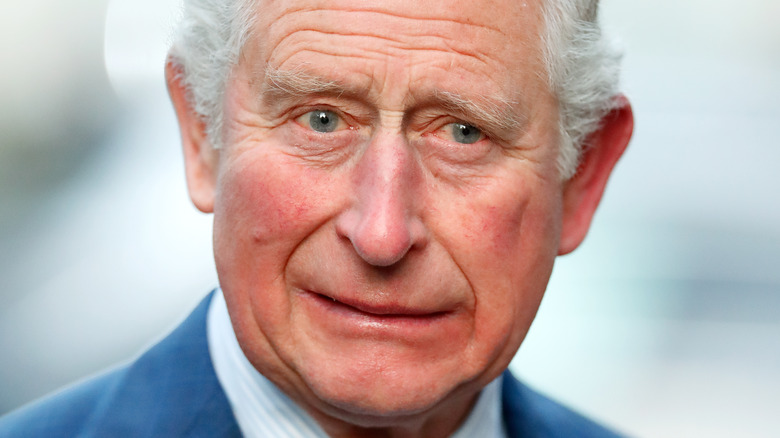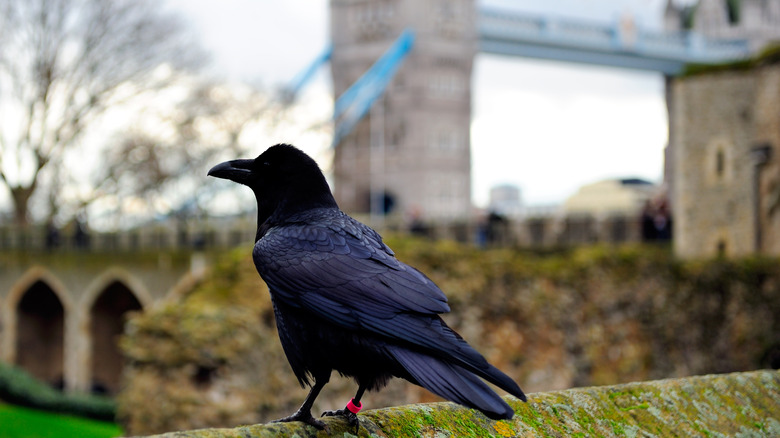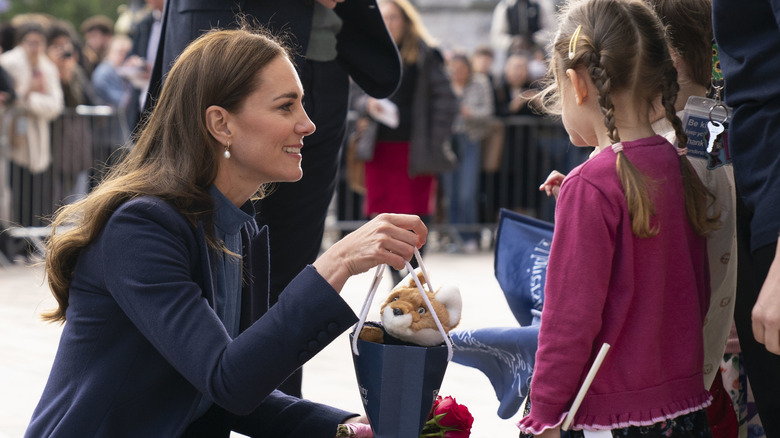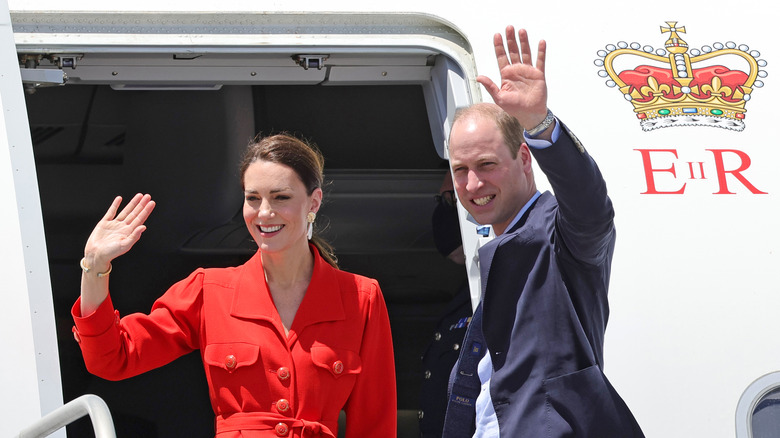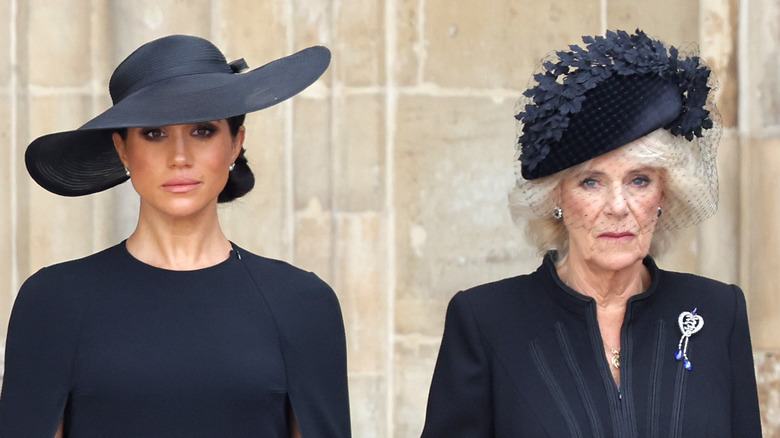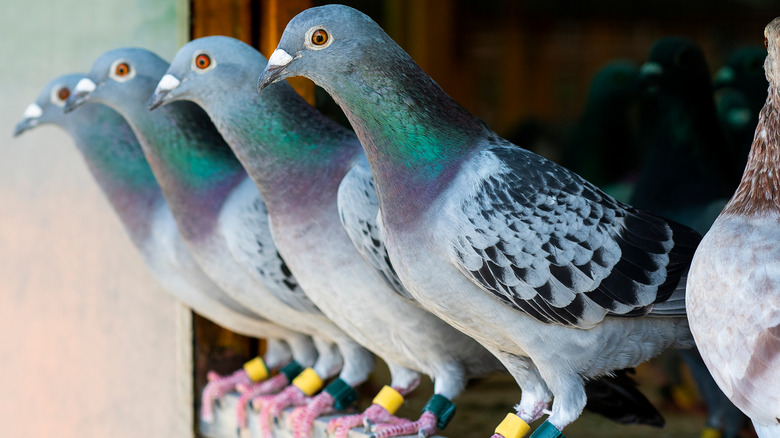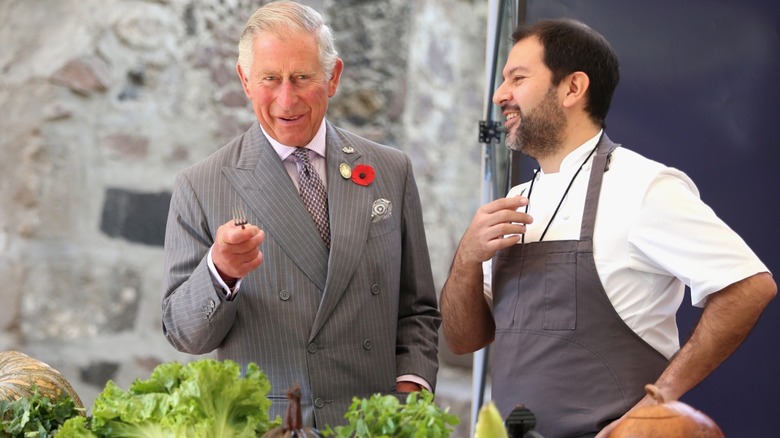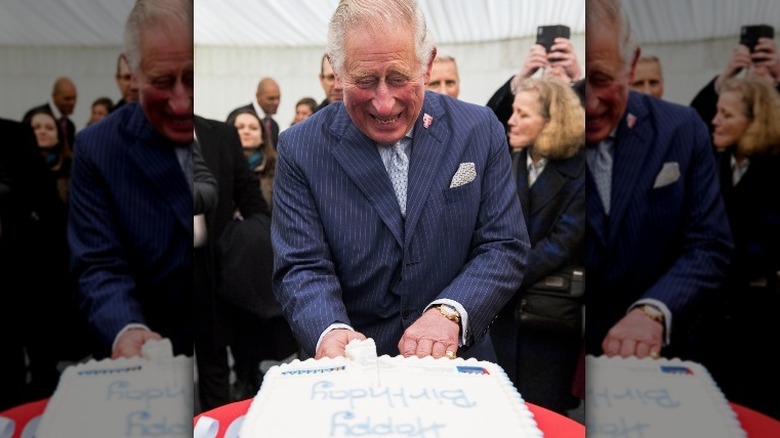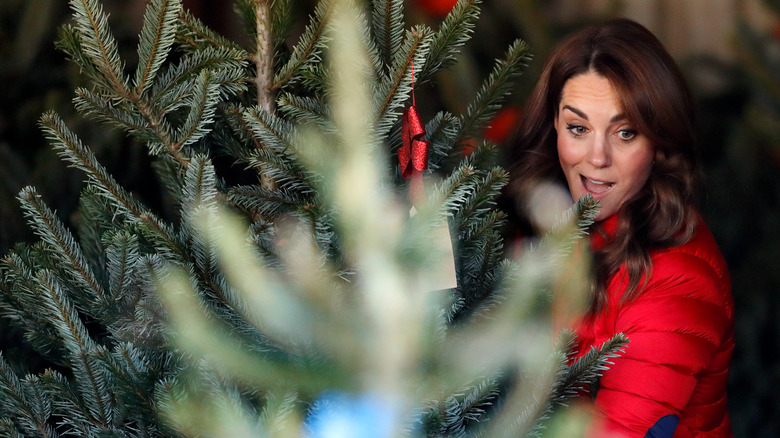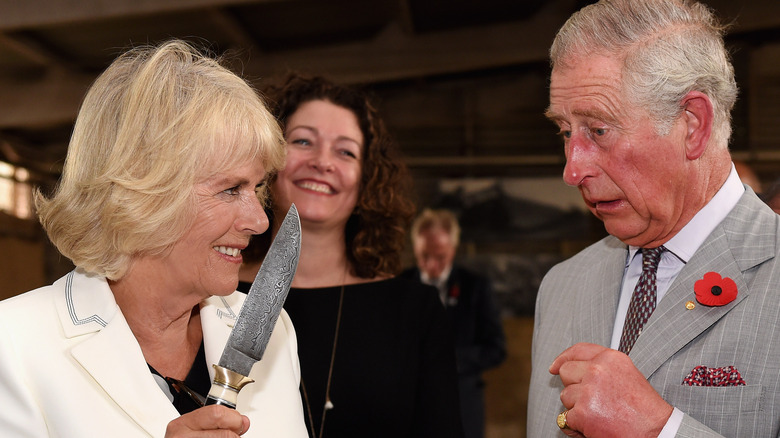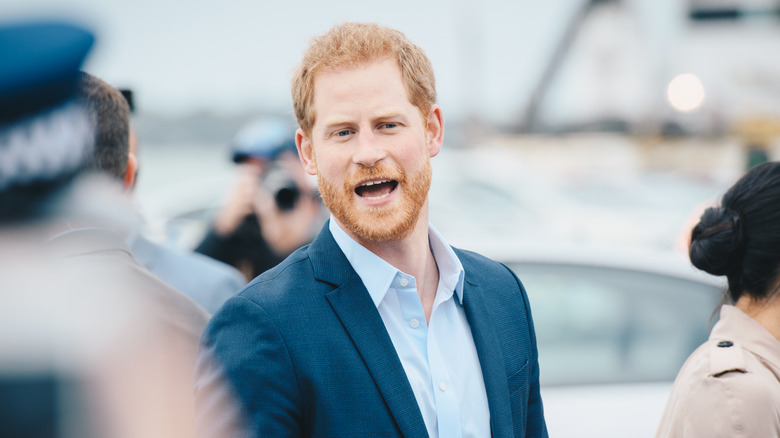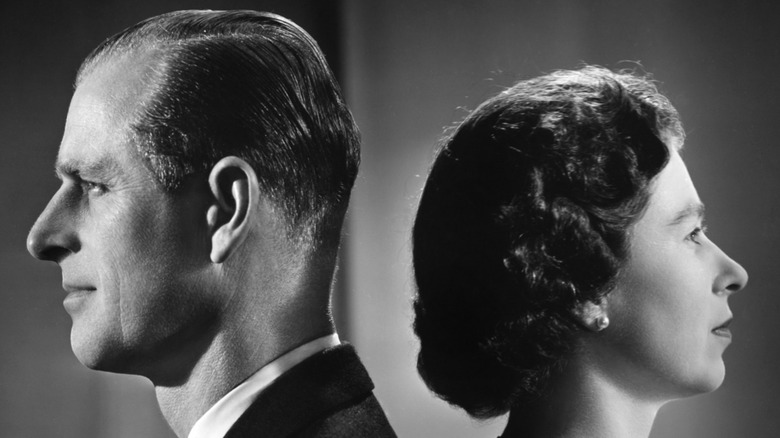Really Weird Things About The Royal Family
Family secrets, strange traditions, and bizarre rituals are the standard for most families. After all, the things that make you and your relatives seem weird can also bring you closer together. Plus, many family quirks end up becoming cherished memories later in life. When BuzzFeed asked readers to share their strange family stories, the responses were priceless. One person revealed that their family keeps a rubber chicken hidden in the kitchen. Another said, "In my family, when cutting the birthday cake, you have to scream as loud as you can when the knife hits the plate." These families are living proof that the world is chock full of oddballs.
If your family is particularly kooky, you should know that you're in good company, because, as it turns out, Britain's royal family just might be the weirdest bunch on the planet. While the royals do their best to appear flawless and uncontroversial at all times, their wacky rules and strange traditions prove that they're nonetheless human. If the royal family can let their freak flag fly, then so can you.
Despite all of their idiosyncrasies, these strange revelations will remind you that the royals are anything but relatable. So, strap yourselves in because it's about to get royally weird.
They have a peculiar superstition about ravens
Ravens have a powerful presence in myths and legends all over the world. In some Native American cultures, for example, the jet-black birds represent creation and higher realms (per the American Museum of Natural History). However, many Westerners see the raven as an omen of doom and destruction. With their menacing eyes and haunting calls, it's easy to justify their eerie reputation. And as it turns out, even the royals are superstitious about ravens.
The Tower of London is a castle almost a thousand years old that sits in the heart of London. Legend has it that in the 17th century, six ravens took up residence in the structure (per Historic Royal Palaces). King Charles II, England's ruler at the time, became convinced that the British empire would fall if the birds ever left the tower. Centuries have passed, but a small group of ravens still roam the fortress grounds, acting as guardians to the Tower of London.
Today, England's legendary Tower ravens remain a colorful and important component of the country's history (per Historic UK). As you can imagine, the lifestyle of a royal tower raven is nothing short of lavish. The flock has its own caregivers, known as ravenmasters, who tend to their every need. Plus, the royal ravens get treated to extravagant meals, such as blood-soaked biscuits.
They have to accept gifts, regardless of how strange
The royal family is known for their polite ways, so it's no surprise that this gracious bunch is required to accept any and all gifts. When it comes to the monarchy, gift-giving is no easy task. After all, the dynasty already has all of the riches they could ever want. Plus, thanks to a 700-year-old statute, they even own all of the sturgeons, porpoises, whales, and dolphins in British waters (via Travel + Leisure). This begs the question: What do you get for the family that has it all?
Turns out, the royal family has received a lot of heartfelt and personal gifts from the public. Admirers have showered them with some truly unique presents, including ketchup samples, boxes of mangoes, and a rug (via The Royal Family). Britain's allies also go all-out with their royal gift-giving. According to the Royal Collection Trust, Queen Elizabeth II received an assortment of extravagant foreign gifts during her reign, including two hippopotami from Liberia, a Nile crocodile from the Berending People of Gambia, and an elephant from Cameroon. All of these creatures found permanent homes at the London Zoo.
Despite the family's graciousness, some gifts do remain off-limits. For example, the board game Monopoly is a no-go with the royals. In 2008, Prince Andrew reportedly spilled the beans about this strange rule, telling The Telegraph that Monopoly is banned from palace game nights because the competition gets "too vicious" between family members.
Royal family members travel with bags of their own blood
As demonstrated by the death of Queen Elizabeth II, a royal expiration triggers massive changes within the monarchy. Therefore, the royal family takes extreme measures to shield themselves from an early grave. And what better way to persevere your longevity than to travel with a potentially life-saving supply of your own blood? As The Sun reported, the royals are required to do just that. Although it may seem a bit creepy, these blood bags are a vital precaution. If a regal ever requires an emergency transfusion while abroad, it's convenient to have a fresh supply of their own blood already on hand. This weird protocol is especially handy for traveling to locations where donor blood isn't readily available.
To mitigate the risk of a medical emergency, there are other rules that globetrotting royals should follow. For instance, a royal ban on shellfish helps the family dodge food poisoning (via the BBC). Additionally, it's been reported that King Charles III travels with his own stash of alcohol as a precaution against assassination by poison (via Express). Poisoning might sound like a fate straight out of "Hamlet," but it's a legitimate concern when you're the King of England.
They always have funeral attire on hand
In the event of a monarch's death, all eyes will be glued to the royal family. It's hard to bear the thought of losing a loved one, but the royals must be ready for such an event because they're expected to lead England in a national period of mourning. To ensure they're prepared to honor a deceased family member, the regals must always travel with black clothing (via Express). This rule stems from a real-life event involving the late Queen Elizabeth II.
When a new monarch ascends the throne, it's almost always due to the tragic death of a close family member. Queen Elizabeth II rose to power immediately after the passing of her father, King George VI, in 1952. Although the King had suffered a streak of illnesses related to lung cancer, his death was nonetheless unexpected (via Time Magazine). At the time of his death, Elizabeth was deep in the backcountry of Kenya.
Since Elizabeth was thousands of miles from home, the grieving royal did not have a customary black dress on hand. Fortunately, palace staff were able to hand-deliver a black dress to the new sovereign as soon as her plane touched down on British soil (via Harper's Bazaar). The moment — which was depicted on Netflix's "The Crown" — showed Queen Elizabeth stepping off the plane in a solemn, dignified outfit that conveyed her grief to the world.
They participate in pigeon races
If the concept of pigeon racing sounds baffling to you, allow us to explain. The gist is that hobbyists, known as pigeon trainers, release their pigeons hundreds of miles away from home, knowing that the birds' instincts will guide them back — provided that the birds survive the journey (via The Guardian). When the pigeons return, trainers calculate the average speed of each bird, and the fastest pigeon wins. Pigeon racing has also been majorly impactful during times of war when pigeons were used as messengers (per NBC News). As reported by the Royal Pigeon Racing Association, 32 pigeons were awarded medals for their service during World War II.
The royal family's foray into pigeon racing began in 1886 when they received their first flock as a gift from the King of Belgium (via the Royal Pigeon Racing Association). Royal curiosity for the sport grew into a serious passion, and the palace soon established its own pigeon racing loft at the family's Sandringham Estate. However, not everybody is impressed with this royal hobby. Animal rights groups condemn pigeon racing as inhumane and have criticized the royal family for taking part in it. In a statement against the sport, PETA UK alleged that as many as 90% of racing pigeons do not return home safely after the grueling events (via Express).
Royal dinner conversations are carefully curated
For some of us, large gatherings can be quite overwhelming. But oversized soirees are no problem for the monarchy, who have a set of protocols that make royal dinner parties as painless as possible. For one thing, dinners are planned way ahead of time — sometimes up to a full year in advance (via The Royal Family).
Every element of a royal dinner is curated right down to the chairs, which are painstakingly placed 45 centimeters apart (via Express). Before festivities commence, the sovereign and their spouse closely inspect the scene to ensure that every last detail is immaculate. Royal dinner guests aren't expected to do anything besides kick back and enjoy the lavish dining experience.
At the royal dinner table, conversations follow a simple flow. The sovereign starts by chatting up the person to their right while the second course of the meal is spent interacting with the guests on the sovereign's left side. This and other steadfast dining rules have been observed by the regals since the 18th century (via South China Morning Post). Another perk of dining with the royals is that you never have to worry about that weird uncle going on an unhinged political rant. That's because heavy and divisive topics — like politics, sex, and religious matters — are not to be discussed at the royal dining table.
Sovereigns have two birthdays
If you're a fan of over-the-top birthday celebrations, try to contain your jealousy when we tell you that sovereigns have, not one, but two birthdays. Why do our fair kings and queens need two birthdays, you may ask? The answer appears to be quite simple: they just want to. The sovereign's bonus birthday is known as Trooping the Colour, and it marks the day that the head of state celebrates their birthday with the British public (via Town & Country). The annual tradition was instituted in 1748 by King Charles II. Like many fall and winter babies who've had their birthday plans spoiled by inclement weather, King Charles II yearned to have a summer birthday soiree so he created one for himself. Thus, Trooping the Colour takes place each year during the month of June. The tradition held strong with Queen Elizabeth II, whose official birthday was April 21st, and it will continue with King Charles III.
In a celebration that would put any birthday bash to shame, Trooping the Colour features an ensemble of 1,400 soldiers, 200 horses, and 400 musicians all parading through the streets of London (via The Royal Family). It's also an opportunity to see the monarchs in person as they ride on horseback or carriage. The day ends with a royal military flyover and an illustrious appearance by the family on the balcony of Buckingham Palace.
Royals reportedly have to weigh themselves before and after Christmas
If you've seen "Spencer" — the 2021 psychological thriller — then you're already familiar with the strange rule that royals must weigh themselves before and after the family Christmas celebration. The unsettling nature of this tradition is captured early on in the film when Princess Diana — played by Kristen Stewart — is coerced into sitting on an antique scale. In the scene, Diana recalls that guests have to put on a minimum of three pounds before the end of the festivities. Never mind counting smiles, laughter, or compliments as a measure of Christmas cheer; according to this supposed tradition, the royal family is expected to count pounds (via The Sun).
Following the premiere of "Spencer," viewers had a lot of questions about the bizarre tradition — and for good reason. At best, the practice is totally invasive, if not deeply triggering. Audiences were desperate to know whether the scene was based on real events, or if it was just part of the murky, nightmarish tone of the film. Cue Ingrid Seward, a royal expert and the editor-in-chief of Majesty Magazine. Back in 2018, Seward had addressed the royal Christmas tradition to Grazia Magazine. The interview seemed to confirm that the royals actually do weigh themselves before and after Christmas.
The palace takes a hostage each year
Each year during the State Opening of Parliament, one member of the public is in for a very strange day. That's because the royal family takes a hostage during the event. This isn't the royal family's idea of a twisted prank — it's actually a precaution to help ensure the family's safety during the proceedings.
For those on the other side of the pond, the Opening of Parliament is an event that brings together all branches of parliament to introduce policies and legislation for the upcoming year. Like any royal event, it involves a flashy royal procession and some traditional monarchical relics. According to Historic Royal Palaces, the hostage-taking tradition was prompted by the demise of King Charles I, who was executed in 1649 by supporters of parliament.
The hostage is usually a member of the Metropolitan Police. If anything were to happen to the monarch during the Opening of Parliament, it would be bad news for the hostage. No captive has been harmed so far, but plenty have gotten to enjoy a bit of royal hospitality. One former hostage recalled his experience to the BBC: "[They] made it absolutely clear I could do anything I wanted in Buckingham palace. ... They [didn't] actually lock me up, but they made it quite clear that I wasn't going anywhere."
They are forbidden from using certain words
As bastions of politeness and decency, the royals are expected to speak with the utmost grace. This means that you likely won't hear the monarchs dropping any dirty words. Curiously, though, curses aren't the only words on the royal family's blacklist. In fact, there's a medley of seemingly normal words that are forbidden to pass through royal lips. Since many of us use these words every day, we'd all be considered potty months by the monarchy's standards.
No self-respecting royal would dare utter the word "toilet." According to Express, Queen Elizabeth II considered the word to be totally unbecoming, so the terms "loo" and "lavatory" have been adopted by the monarchy, instead. If you want to talk like a royal, forget about using the word "couch." According to Reader's Digest, our snobby sovereigns believe that couches are something you'd only find in the homes of the lower class. In the palace, they sit on "sofas" instead. "Perfume" is another word that the royal family snubs their noses at. Instead, the regals would advise you to say "scent."
Queen Elizabeth and Prince Philip were related
There's no shortage of branches on the royal family tree. Although it may be difficult to keep up with the royal bloodline, it's clear that the British royals have done quite a bit of intermingling with their cousins. In fact, you might be surprised to find that many of your favorite royal pairings share some common DNA. Queen Elizabeth II, for example, was the third cousin of Prince Philip, her husband of 73 years. According to Insider, the familial link between these monarchs is Queen Victoria. Prince Philip was the great-great-grandson of Victoria by his maternal lineage. Meanwhile, Elizabeth was Victoria's great-great-granddaughter through her paternal side.
It might seem unusual for cousins to marry, but British royals have been doing so for a very long time. For the monarchy, it's not only normal but it's actually seen as favorable, especially for diplomatic purposes. According to Reader's Digest, former spouses Princess Diana and King Charles III were distant cousins — seventh cousins, once removed, to be exact. Prince William and Princess Catherine are also distantly related. The royal "it" couple are eleventh cousins, once removed.
